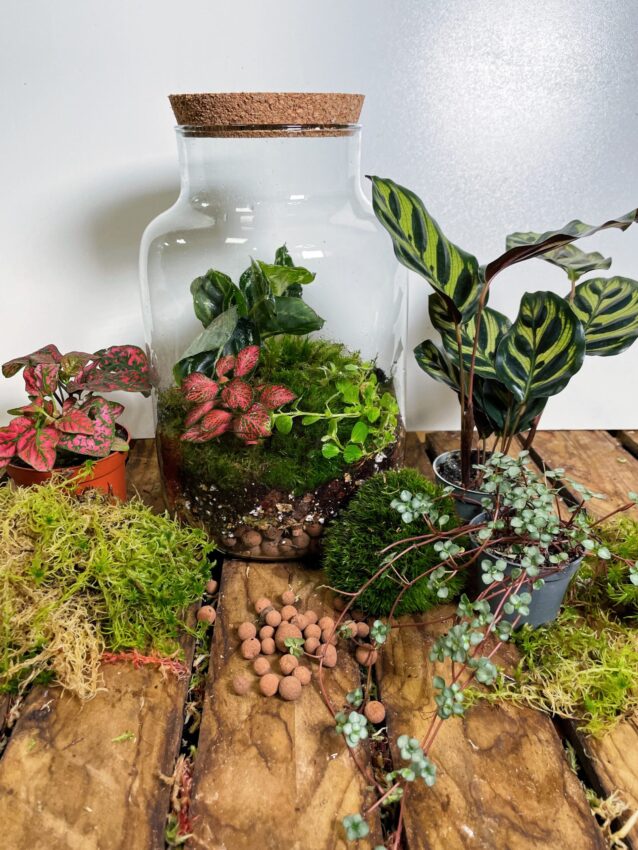About
Cushion moss has to be a strong contender for the best moss to use when building any terrarium, vivarium, moss bowl or box. This gorgeously stunning little mound of nature can elevate these kinds of craft projects to a whole new level. With its deep earthy green colours and beautiful tiny tufts, it truly is one of a kind.
Cushion mosses’ formal name is Leucobryum glaucum and belongs to the White Moss family. This incredibly temperate and adaptable moss can be found all across North America and Europe and is classified as acrocarpous moss. Acrocarpus means it grows tight and compact instead of branching out and growing taller, this is one of the features that makes it so well suited to a terrarium. These majestic clumps of wonder love to grow in woodlands and wetlands, as well as other well-shaded and moist rich environments, they can vary from a few centimetres across all the way up to large family-sized clumps, of one metre or more.
Also commonly known as; Pincushion moss, Pillow moss or Bun moss all based on their unforgettable looks this incredible plant is also very practical as well as being easy and highly effective to use in an array of plant projects. Mainly used for terrariums, moss bowls and our carnivorous bog gardens. Leeucobryum glaucum can be torn apart and broken up into any size chunk you need to fill any sized gap in a tiny indoor mossy landscape. Compared to most mosses it is very easy to place in tight spaces making it highly desirable and easy to use. This compact little moss will also never outgrow the space making it the perfect low-maintenance choice, as it matures the tiny leaves of this moss only grow fleshier enhancing their look further while taking up no further space.
Overall, whether using live or preserved moss, if you have never used cushion moss before you’ve been missing out. These unique, dense, versatile and compact cushions of mossy goodness are a perfect choice to add to your next plant project.
Light
Unlike a lot of other mosses, which can only tolerate shade or low light conditions, cushion moss thrives in bright indirect sunlight. This moss can also tolerate a touch of direct light, while it’s not ideal, a touch of morning sunlight won’t harm it and can sometimes provide some benefit. But like all plants, there may be a bit of trial and error moving it around to find the ideal location for it to thrive.
Be careful placing cushion moss in low light conditions where it won’t receive any ambient bright indirect light, this can cause the moss to start turning yellow. While it will survive in these conditions it will never be able to perform at its best as it will always need a degree of bright light in order to thrive.
Humidity
Humidity is critical to living moss and will play a crucial role in how well it performs. While cushion moss is a very tolerant and adaptable moss, in the best conditions this plant will need 90%+ humidity to really be happy and perform well. This is actually very achievable in almost all closed-top terrariums where it will be best suited for use.
That being said, you can still keep this moss happy and thriving in open-top terrariums and living moss bowls, you may just need to keep a closer eye on them and give them more regular care. It’s best to soak the moss to fully hydrate it and squeeze off any excess water before using, this will help it from drying out so quickly. Paired with regular misting you should do just fine!
Water
Follow the guidelines above to maintain adequate moisture levels to ensure a healthy colour and long-term survival. Making sure the moss is not allowed to dry out is crucial to keeping the lush natural look of the plant.
In the scenario that your moss has already been placed, it is always best to use a mister to water. Trying to water this plant by pouring the water can result in disaster and cause a knock-on effect of complications due to the increased risk of over-watering. Depending on your location and the quality of the water, it can be good practice to avoid tap water, which in some cases due to the chemicals, can cause cushion moss to turn brown and lackluster. In this case, it would be best to use filtered water or rainwater.
Soil
In all honesty, the soil is not too important as it will be getting almost all the moisture it needs directly from the air in its environment, so it will be comfortable on almost any soil type as long as the humidity is high enough.
But the likelihood is this plant will be used in a terrarium so with that in mind a specific terrarium compost will always perform better than just regular compost.
It is good to remember that on the contact point with the soil cushion moss creates tiny root-like structures called rhizoids, so it is helpful to the plant if you gently press down and firm it against the soil to help bridge the anchor between the moss and the soil.
Feed
Live cushion moss does not require any feed or fertilizer, they receive all the nutrients they need in order to thrive and survive directly from the air around them and the sun.
If they have been placed in an environment where the surrounding plants need feeding, then it is crucial to use a heavily diluted mix. Otherwise, the moss will start to turn brown and begin to struggle.
Preserved Moss
Preserved moss is the answer to all of our prayers. This maintenance-free alternative to live cushion moss is exceptionally useful as it provides you with a similar look whilst not having to worry about environmental conditions, watering or maintenance. Preserved cushion moss is the ultra easy-to-use alternative that can last for an incredibly long time while maintaining the beautiful natural mossy look that this plant is so good at providing.




